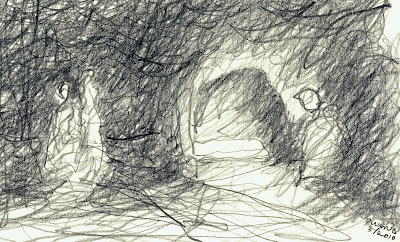
Throughout the centuries, art history has left us a rich tradition of femmes au tombeau, or women at the tomb. As Easter approaches, here is a rendition I did in pencil.
This is an early Medieval depiction by Giotto (1304). Perspective projection was just becoming a factor in Western art. The figures look like cutouts placed over a flat plane.
Here is the same theme by Fra Angelico (1400-1455), early Italian Renaissance. Still the flattened plane of medieval painting. The artist's interest is not this physical world, but depiction of a spiritual reality.
This one is by Hubert van Eyck, older brother to Jan van Eyck, painted 1425. Always the importance of the landscape in this northern tradition. Notice how much more the resurrection is set in the nature of this world when compared to Angelico's, which is roughly contemporary.
This one is from the Renaissance, by Marco Palmezzano (1506). By this time, the setting is not only this "real" world, it is all about the affairs of this world: note the politics represented by the various flags.
Here is The Holy Women at the Tomb of Christ, Annibale Carracci (1560-1609), Italian Baroque. Painting used in service of psychological effects was the innovation of the Baroque. It was during this period -- the period of the Counter-Reformation -- that the Catholic Church used art to emotionally draw the flock back to the fold.
Here is The Holy Women at the Sepulchre, Peter Paul Rubens, Flemish, c. 1611-14. Rubens' signature use of dark in contrast to light.
This is by the French academic painter William-Adolphe Bouguereau (1825 – 1905). The scientific precision of the Enlightenment, admixed with the emotion of the Baroque, persists here.
And this by the post-Impressionist painter Maurice Denis, 1894. The holy theme of femmes au tombeau is now something like what some women saw on an enchanted stroll. The realism of perspective is once again beginning to fade -- this time not into spiritual realities, but into subjective human states. Did these women really see something unusual?
Or was it just a dream?
Logos2Go
Mark 16.1-6 When the Sabbath was over, Mary Magdalene, Mary the mother of James, and Salome bought spices so that they might go to anoint Jesus’ body. Very early on the first day of the week, just after sunrise, they were on their way to the tomb and they asked each other, “Who will roll the stone away from the entrance of the tomb?” But when they looked up, they saw that the stone, which was very large, had been rolled away. As they entered the tomb, they saw a young man dressed in a white robe sitting on the right side, and they were alarmed. “Don’t be alarmed,” he said. “You are looking for Jesus the Nazarene, who was crucified. He has risen! He is not here. See the place where they laid him.
Women at the tomb
Posted by
David Wang
Mar 26, 2010
1 comments:
I like the Bouguereau and Carracci versions. And yours, of course. :)
Post a Comment